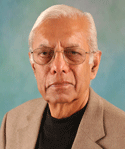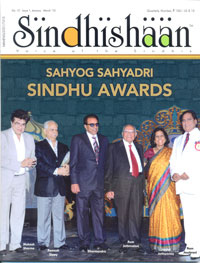VEDAS-Part 2
The Spiritual Teachings
by Dr. Hiro Badlani

Chains of the ancient Rishis meditated on riverbanks, mountaintops, and in the forests. In their deep sojourns, they established a secure communion—yoga--with the Divine. From this spiritual union, they heard the inner voice of God and created thousands of sacred hymns, which would form the eternal Vedas. The Vedas were not created by a single author but by many highly enlightened and virtuous masters. These scriptures attained supreme authority, which is still considered sagacious. In Hindu theology however, no one scripture is considered as the sole authority. Many scriptures followed one another, often the newer scriptures proclaiming many significant changes and modifications from the older ones. The old teachings were respected and revered but subtly changed as the situation and circumstance demanded. Dynamic character became visible, but no force or violence was deployed. This pattern of reverence for the old and subtle non-violent transitions periodically was also adopted in the emerging family tradition of Hindu society.
The concept of Hinduism thus has grown out of the merging of many sects and cultures of different origins, joining together with greater freedom to pursue their individual customs, manners, practices, and languages. It is like a mighty ocean of thought, which has risen from the confluence of many small and large, old and new rivers of philosophy and doctrine. The origin of Hinduism fixedly belongs to India, without contest. Max Muller also confirms “the Vedic religion was the only one the development of which took place without any extraneous influences.”
The Vedas contain a treasure trove of spiritual teachings in the form of mantras and slokas. The main philosophy of the Vedic teachings may be summarized in the interpretation of the following mantras and slokas:
Shanti Karanam: the hymns of peace. These hymns are included in all the Vedas. Among these hymns, the Gayatri Mantra undoubtedly occupies a place of prestige.
OM
Bhur bhuvah suvah
Tat Savitur varenyam
Bhargo devasya dhima
Dhiyo yo nah prachodayat
Rig Veda, 1.113.13
We meditate on the earth (bhur), the cosmic atmosphere (bhuvah), and heaven (svar-suvah). We meditate on the early morning sun (savitra) to grant us a good mind (gayatri).
Hindu sages invoked all the nature gods and especially the rising, effulgent sunrise savitra for granting the noble mind, the sacred gayatri. They observed the symbolic but spiritual bond between the early rising sun and the (spiritual) augmenting of the human mind. They hailed the boundless supremacy of the sun (suray) in everyday life. They also recognized the prerogative of the early morning period on the development and creation of good mind (sumati). Hindu Rishis eventually honored the mind as the cornerstone of all human impetus and evolution.
Other hymns of peace—Shanti Mantras:
May our prosperity, prayers and wishes, elevated intellect and riches be auspicious to us. May our truthful speech based on noblest intensions bring us welfare. May those that are entrusted with the task of dispensing justice be men of wide fame and prove auspicious to us, and may the prayerful hymns of saintly persons give us peace.
Rig Veda, 7.35.3
There is a clear call for prosperity, auspiciousness, high intellect, and truth in this mantra. The phrasing of such mantras points toward an advanced level of cultural progress of the society at such an early period of history.
May the rising of the glorious sun, shedding his rays over vast regions, be auspicious to us. May the mountains be of use to us, and the rivers, and subsoil waters be beneficial to us. May water and air be agreeable to us.
Rig Veda 7.35.9
The respectful attitude toward nature is unique in ancient Hindu thought. It differs markedly from that of the modern science, which until very recently always boasted of conquering and exploiting nature for the material benefit of mankind. We Sindhis have our Ishtdevta—the personal god Jhulelal—the god of water, whom we pray so lovingly and reverently.
In these peace and prosperity mantras, the nature deities are eulogized and worshipped. Peace (shanti) became a watchword in Hindu philosophy. Swami Vivekananda said “Every word has been spoken with a blessing behind and peace in front of it.”
After this period came the concept of the formless, transcendental, universal God. The transition, however, was gradual and subtle; the nature gods were not disregarded, ever. This would become the exemplary of transformation in Hindu philosophy.
May He, the Lord of the universe, bless our bipeds and quadrupeds.
Yajur Veda 38.8
Hindu society started to become caring and benevolent to all creatures very early in ancient times.
O Lord, whereby the learned, ever given to meditation, performance of virtuous deeds, and regulation of their faculties in right channels, are active in the discharge of their selfless duties and thoughtful in the acquisition of scientific and political knowledge and deliberative in assemblies and other places where knowledge is disseminated, and which is a unique something, the common center of all senses, bestowed upon all, may that mind be of noblest resolve.
Yajur Veda, 34.3
The mantra portrays a very high degree of virtuous and intelligent mind, which reflects the cultural advancement.
(O Almighty God) Om, in whom the Vedas have their origin and who pervades all the elements, my soul is Thy fuel. O Agni (lord of fire), blaze intensely with this, advance and bless us with worthy offspring, with good cattle and animals, with divine glory, plentiful food, and spiritual advancement.
Yajur Veda, 3.1
The mantra exhibits a harmonious blending of the nature god, Agni, with the transcendental God, Om. It also is a good mix-up of material and spiritual elements; both are considered to be necessary baggage for human progress.
Ekam sat vipra bahauda vadanti
Rig Veda I.164.46
What is one, the sages give many names. This ancient Hindu concept of essential unity of all beings sowed the seeds of universal brotherhood and propagated the idea of all beings belonging to one divine family of God-Vasudhaiva Kutumbkum. Later these spiritual teachings flowed to other parts of the world. It is believed that as many as eighty-four thousand monks were sent out of the country to propagate the spiritual message of the Buddha, who projected the Hindu concepts in modified form. According to historian Professor Mahaffy, Buddhist monks preached in Palestine and Syria a couple of centuries before the birth of Christ. In the opinion of the learned Anglican priest C. F. Andrews; the ideal of ahimsa (nonviolence) was planted in a holy manner from the Hindu origin.
Let noble thoughts come to us from all sides
Rig Veda 1-89-1
Corruption in Vedas is Hydra headed with nine Heads. It enters human body through ninety nine sources. (Later it was depicted in 9 corrupt heads of Ravana and 99 corrupt sons of blind Kaurva king Dhritrashtra. Ramayna and Mahabharta are Vedas re-told as Epics.) Hydra headed vices include bribery, sloth, doubt, attachment, gambling, deception, food adulteration, miss-appropriation of public funds etc
Sam Veda 179 and 913
Rulers should not allow corrupt people to mix with others to avoid spread of evil in society. Such corrupt people face gloom through their children
Rig Veda 2-2-12
Selfless action by all sections of society can lead to material and spiritual prosperity
Rig Veda 1-191-8
Accept only truth and give up untruth
Rig Veda 1-139-2
Scientific knowledge is need for enlightened life
Rig Veda 1-85-7
Nothing for self and all for society
Rig Veda 1-140-1
In view of the Vedic concept of spiritual brotherhood (Vishwa bandhutva), and Global familyViswa Kutumbkam), Vedas recommend Global Trade for the welfare of mankind:
Idam na mmam
Rig Veda 1-41-112.
Exact weighing by merchants
Yajur Veda 30-17
Vedas prompted for the virtues of truth, non-violence, integrity, peace, harmony and prosperity.
Vedam Chanting has now become very popular in many Western countries. Often we think that chanting these Sanskrit Mantras without properly understanding the meaning is merely a blind ritual. However there has been enormous appreciation of these Mantras and Slokas of the Vedas in many places. These are recited in original authentic spiritual tunes with complete devotion in many places. European Veda Union Group of Sri Sathya Sai Baba devotees has become trendy across many Western countries. It is believed that chanting these Mantras in proper method creates a mystic energy and augments the spiritual virtuous mind.
The Gayatri Mantra is broadcast daily for 15 minutes from 7 P.M. onwards over Radio Paramaribo, Surinam, South America for the past two years, and in Amsterdam, Holland for the last six months. British school children sing the Vedic hymns on special functions. Vedic Mantras are recited very regularly in many official state events and gathering in U.S.A. as a commonly accepted policy of encouraging all multiple faiths.
Music albums of the Vedic Mantras by international artists like Deva Premal (German Singer) and others are sold in millions across the globe!
It may be interesting to note that the origin of the Sindhi language can be traced to an Old Indo-Aryan dialect, or primary Prakrit, that was spoken in the region of Sindh at the time of compilation of the Vedas (1500–1200 bce) or perhaps some centuries before that. Glimpses of that dialect can be seen to some extent in the literary language of the hymns of the Rig Veda.
Historically, the Sindh region suffered frequent invasions. It was conquered by the forces of Islam in 712 C.E. and remained under Muslim rule until the British conquest in 1843. Hence, the Sindhi language borrowed many Arabic and Persian words. In spite of this, the basic vocabulary and grammatical structure of Sindhi has remained mostly unchanged.
Like other languages of this family, Sindhi has passed through Old Indo-Aryan (Sanskrit) and Middle Indo-Aryan (Pali, secondary Prakrits, and Apabhramsha) stages of growth, and it entered the New Indo-Aryan stage around the 10th century C.E.
(Dr Hiro Badlani is the author of Hinduism: Path of the Ancient Wisdom www.hinduismpath.com. He lives at Los Angeles and can be contacted at hgbadlani@aol.com).


